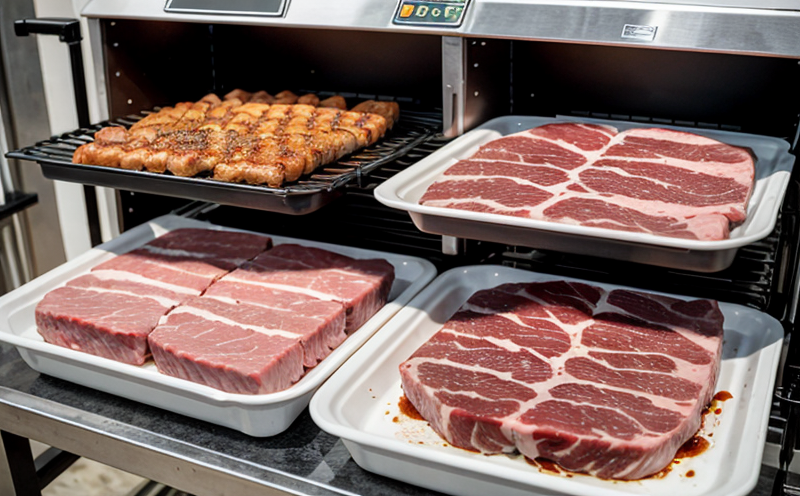ISO 27656 Mercury Quantification in Meat Samples
The quantification of mercury in meat samples is a critical process within the food and feed sector, particularly for products like poultry and meat. This service adheres to ISO 27656, ensuring accurate and reliable determination of mercury levels which is essential for maintaining product safety and compliance with international standards.
Mercury contamination can occur due to various environmental factors or during production processes. Elevated levels of mercury in food products are a health concern as they can lead to neurotoxic effects even at low concentrations. This service ensures that meat samples meet regulatory limits, protecting consumers’ health while also ensuring the integrity and reputation of food products.
The process involves the following steps:
- Sample preparation: Meat samples undergo thorough cleaning, homogenization, and digestion in a controlled environment to ensure accurate results.
- Instrumentation: Samples are analyzed using an atomic absorption spectrophotometer (AAS), which is highly sensitive and precise for detecting mercury levels.
- Data analysis: Results are compared against the ISO 27656 standard, ensuring that they meet specified limits.
Our team of experts ensures that every step in this process adheres strictly to ISO 27656 guidelines. This includes precise sample preparation, calibration of instruments, and robust data analysis techniques. By doing so, we provide clients with accurate and reliable results that are crucial for regulatory compliance.
The service not only meets the needs of our customers but also contributes significantly to public health by ensuring that food products are free from harmful contaminants. It is a cornerstone in maintaining the quality and safety of meat products.
Why It Matters
Mercury contamination in food, especially meat and poultry products, poses significant risks to human health. Exposure to mercury can lead to severe neurological damage, particularly in infants, children, and pregnant women. The quantification of mercury levels is therefore essential for ensuring product safety.
Regulatory agencies around the world have established maximum permissible limits for mercury in foodstuffs. Compliance with these standards is mandatory for manufacturers to avoid recalls, fines, and potential legal actions. Moreover, consumers are increasingly demanding safer products, making it crucial for producers to adhere to stringent quality control measures.
The ISO 27656 standard provides a robust framework for quantifying mercury in meat samples. By adhering to this standard, laboratories like ours ensure that the results are accurate and consistent across different batches and locations. This not only enhances product safety but also builds trust between manufacturers, regulatory bodies, and consumers.
The importance of this service extends beyond just compliance; it plays a vital role in protecting public health. By detecting even trace amounts of mercury, we can prevent the distribution of contaminated products to the market, thereby safeguarding consumer well-being.
Applied Standards
| Standard | Description |
|---|---|
| ISO 27656 | This standard provides a detailed procedure for the determination of mercury in meat samples using atomic absorption spectrophotometry. |
The ISO 27656 standard specifies the methodological approach to quantifying mercury in meat samples. It outlines the sampling procedures, sample preparation techniques, and the use of appropriate instrumentation such as atomic absorption spectrophotometers (AAS). Adherence to this standard ensures that the results are accurate, reproducible, and reliable.
The standard also sets out acceptance criteria for the quantification process, which include precision, accuracy, and the limits of detection. By following these guidelines, laboratories can ensure that their findings meet regulatory requirements and provide confidence in the quality of the meat products being analyzed.
International Acceptance and Recognition
- ISO: The International Organization for Standardization recognizes ISO 27656 as a global standard for mercury quantification.
- ASTM: ASTM E1526, a widely recognized international standard, also includes methods applicable to mercury quantification in food products.
- EMEA: The European Medicines Agency endorses the use of ISO standards for quality assurance purposes, including ISO 27656.
- WHO: The World Health Organization recommends the application of ISO 27656 for ensuring food safety and public health.
The widespread acceptance of ISO 27656 in regulatory frameworks underscores its importance. Regulatory bodies worldwide have incorporated this standard into their guidelines, emphasizing its role in maintaining product safety and compliance. This recognition ensures that the results from our laboratory are internationally accepted and widely recognized across different regions.
By adhering to these standards, we ensure that our services meet the highest international benchmarks for accuracy and reliability. Our clients can trust that the results they receive are not only compliant with local regulations but also align with global best practices in food safety.





